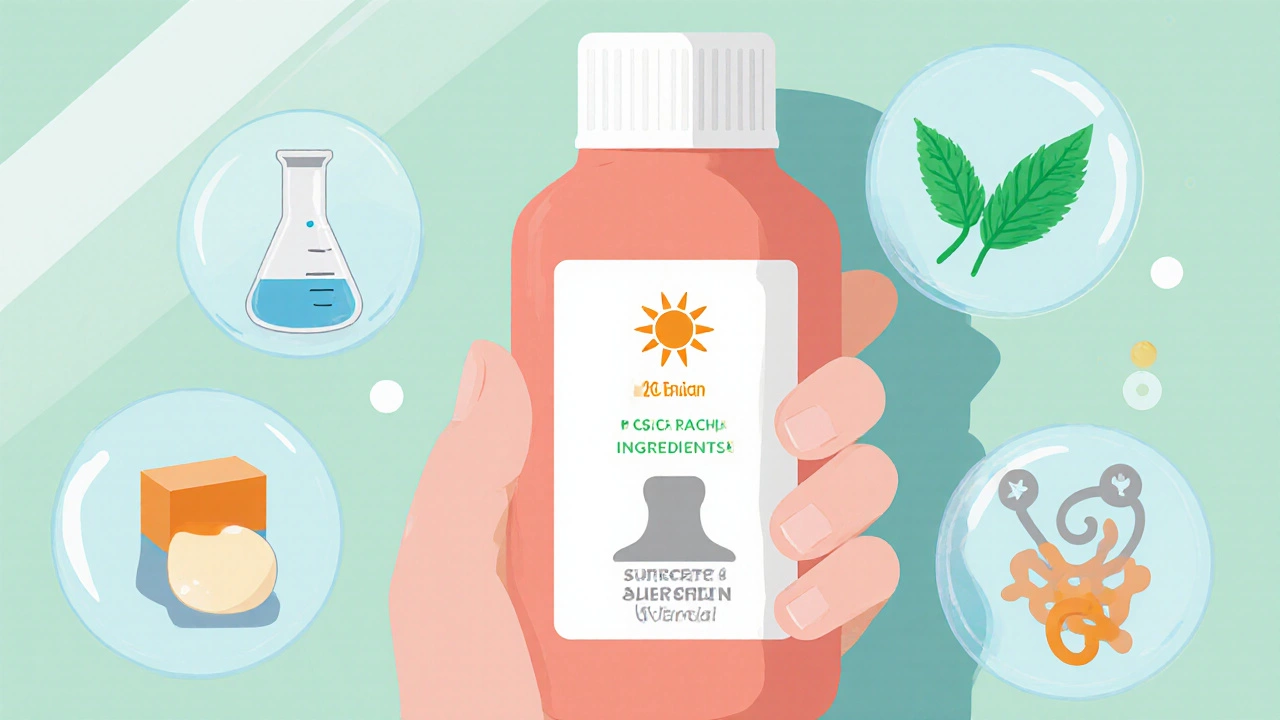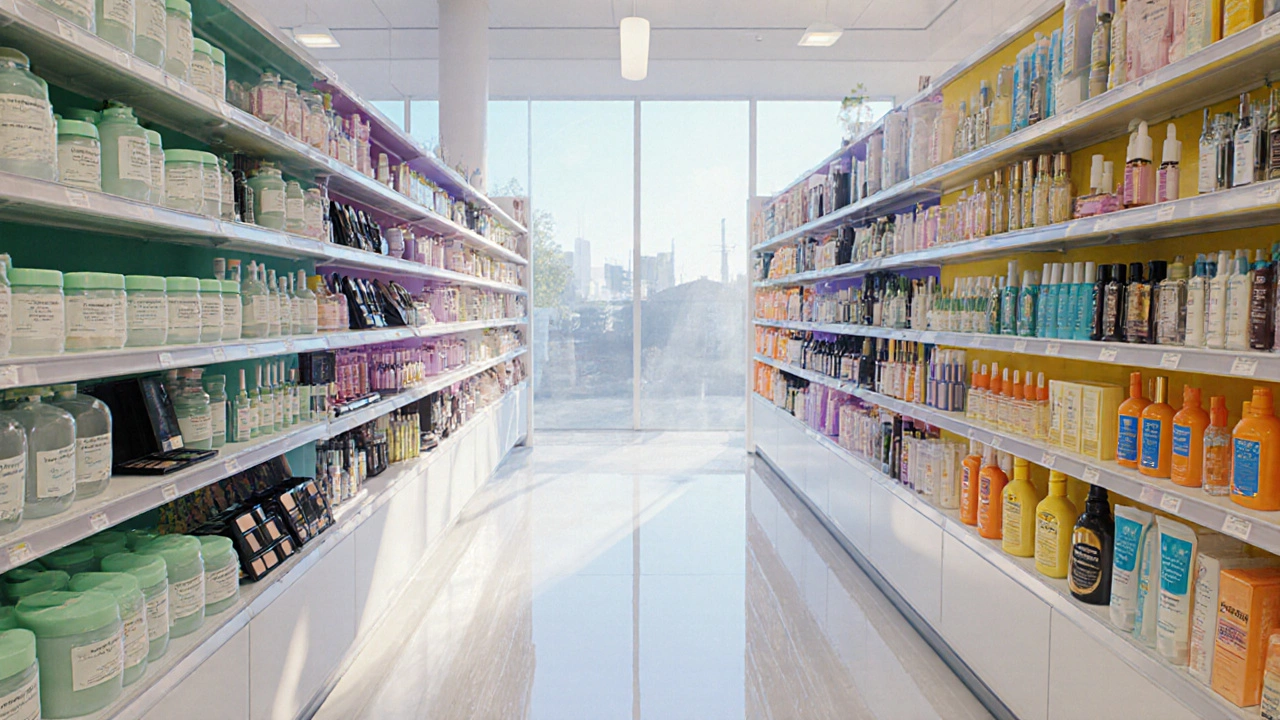Cosmetic Product Category Explorer
Explore the main categories of cosmetic products and learn about their purposes, typical ingredients, and usage frequency.
Skincare
Hydration, protection, anti-aging
Glycerin Shea Butter Vitamin CDaily use (morning & night)
Makeup
Conceal, highlight, express style
Iron Oxides Silicones ParabensOccasional or daily use
Fragrance
Provide pleasant aroma
Essential Oils Synthetic Aromatics AlcoholAs needed (once per day)
Hair Care
Cleanse, moisturise, shape
Sulfates Silicones Keratin2-3 times per week
Sunscreen
Block or absorb UV-A/UV-B rays
Zinc Oxide Titanium Dioxide AvobenzoneEvery time outdoors
Cosmetic Ingredient Guide
Understanding key cosmetic ingredients helps you make informed choices:
- Preservatives - Keep products from spoiling (e.g., parabens, phenoxyethanol) Safe when used properly
- Fragrance Allergens - Can cause reactions (e.g., limonene, linalool) Check ingredient lists carefully
- Silicones - Provide silky feel and spreadability Generally safe
- Retinoids - Powerful anti-aging agents (over-the-counter retinol) Effective but potent
Label Reading Tips
- Identify the product type on packaging
- Check ingredients listed in descending order of concentration
- Spot potential allergens (26 EU-listed fragrance allergens)
- Look for certifications (vegan, cruelty-free, organic)
- Note the expiry date (PAO symbol indicates 12 months after opening)
When you wander through a beauty store, cosmetic products are items applied to the body for cleansing, beautifying, promoting attractiveness, or altering appearance dominate the shelves. Yet most shoppers only scratch the surface of what counts as a cosmetic, how they’re regulated, and which ingredients truly matter. This guide breaks down the basics, walks you through the main categories, and gives you practical steps to pick safer, more effective items for your routine.
Quick Take
- Cosmetics cover everything from moisturisers to perfume, but they’re not medicines.
- In the UK, the MHRA enforces safety rules; products must be safe when used as intended.
- Look for clear ingredient lists, avoid known allergens, and match products to your skin type.
- Emerging trends - clean, organic, cruelty‑free - are reshaping what’s on the shelf.
- Reading a label correctly can save you from irritation and wasted money.
What Exactly Counts as a Cosmetic?
According to the Cosmetics definition in the UK Cosmetic Regulation (EC) No1223/2009, a cosmetic is any substance or mixture intended for application to the external parts of the human body - skin, hair, nails, lips, or external genitalia - or to the teeth and gums, solely for cleaning, perfuming, protecting, maintaining, or correcting the body. This means that products such as shampoo, sunscreen, and lipstick all fall under the same regulatory umbrella, even though their functions differ widely.
It’s important to note that cosmetics are NOT intended to treat or prevent disease. If a product claims to cure acne, reduce wrinkles dramatically, or act as a sun‑blocking medication, it steps into the realm of medicines and requires a separate, stricter approval process.
Key Categories of Cosmetic Products
While every brand may slice the market differently, the industry generally groups cosmetics into five broad families:
| Category | Primary Purpose | Typical Ingredients | Common Usage Frequency |
|---|---|---|---|
| Skincare products aimed at maintaining or improving skin health | Hydration, protection, anti‑aging | Humectants (glycerin), emollients (shea butter), antioxidants (vitaminC) | Daily (morning & night) |
| Makeup coloring or highlighting products for aesthetic enhancement | Conceal, highlight, express style | pigments (iron oxides), film formers (silicones), preservatives (parabens) | Occasional or daily, as desired |
| Fragrance products that add scent to the body or environment | Provide pleasant aroma | Essential oils, synthetic aromatics, alcohol | As needed (often once per day) |
| Hair Care items designed to clean, condition, or style hair | Cleanse, moisturise, shape | Sulfates, silicones, proteins (keratin) | Usually 2-3 times per week |
| Sunscreen products that protect skin from UV radiation | Block or absorb UV‑A/UV‑B rays | ZnO, TiO2 (physical filters), avobenzone (chemical filter) | Every time you go outdoors |
Ingredients You Should Know
Every cosmetic product is a mixture of ingredients the individual chemicals or natural extracts that give a product its function. While many are harmless, a few have raised safety concerns over the years. Below are the most frequently discussed groups:
- Preservatives - keep products from spoiling. Common ones include parabens, phenoxyethanol, and formaldehyde‑releasers. Some people experience irritation, so look for “paraben‑free” if you’re sensitive.
- Fragrance allergens - even “unscented” products may contain fragrance allergens substances known to trigger allergic reactions in a portion of the population like limonene or linalool. EU regulations require them to be listed if they exceed 0.001% in leave‑on products.
- Silicones - give a silky feel and improve spreadability. They’re generally safe, but some users avoid them for a “clean” routine.
- Retinoids - powerful anti‑aging agents. Over‑the‑counter retinol products are considered cosmetics, but higher‑strength prescription retinoids fall under medicines.
If you’re unsure about a component, a quick web search of the ingredient name plus “safety” will usually surface the latest assessments from bodies such as the EU Scientific Committee on Consumer Safety (SCCS) or the US FDA.

How to Decode a Cosmetic Label
The label is your first line of defense against unwanted reactions. Here’s a step‑by‑step method to read it effectively:
- Identify the product type - the packaging usually states whether it’s a cream, serum, or lipstick.
- Check the ingredient list - ingredients are listed in descending order of concentration. Anything after the word “and” or after the first ten ingredients is present at 1% or less.
- Spot potential allergens - look for the 26 EU‑listed fragrance allergens or common irritants like alcohol denat.
- Look for certifications - terms like “vegan”, “cruelty‑free”, or “organic” are not regulated but can guide your choice if you trust the certifying body.
- Note the expiry date - most cosmetics are good for 12months after opening (indicated by a PAO symbol).
Remember, the label the printed information on packaging that provides product details, ingredients, and usage instructions must be legible, non‑misleading, and written in English for UK sales. If any claim seems vague (“miracle formula”), it’s worth a second look.
Matching Products to Your Skin Type
One size does not fit all. Knowing whether your skin is oily, dry, combination, or sensitive helps you narrow down the best options.
- Oily skin - favor lightweight, water‑based moisturisers, and non‑comedogenic makeup. Look for ingredients like niacinamide and salicylic acid.
- Dry skin - opt for richer creams with ceramides, hyaluronic acid, and occlusive agents like petrolatum.
- Combination skin - use a balancing routine; a gel‑cream in the T‑zone and a richer cream on cheeks works well.
- Sensitive skin - choose fragrance‑free, hypo‑allergenic products, and patch‑test new items for 48hours.
Testing a product on a small area before full application can prevent costly breakouts. If a product triggers redness or itchiness, discontinue use and consult a dermatologist.
Emerging Trends Shaping the Cosmetic Landscape
Consumers are pushing the industry toward more transparent, sustainable, and health‑focused options. Here are the three biggest movements right now:
- Clean Beauty - brands audit their ingredient lists to eliminate controversial substances (e.g., microplastics, certain silicones). While “clean” isn’t a regulated term, many third‑party labs certify claims.
- Organic & Natural - certifications like COSMOS‑Organic ensure a minimum percentage of natural raw material and restrict synthetic chemicals.
- Cruelty‑Free & Vegan - the cruelty‑free label indicating that no animal testing was performed at any stage of product development label has become a selling point, especially among younger shoppers. Look for logos from Leaping Bunny or PETA.
These trends often overlap; a product can be both organic and cruelty‑free, but it’s still vital to read the ingredient list because “natural” doesn’t automatically mean safe for everyone.
Checklist: Choosing Safer Cosmetic Products
- Confirm the product is listed under the UK Cosmetic Regulation.
- Read the full ingredient list; prioritize low‑risk preservatives.
- Identify any known allergens for your skin type.
- Check for third‑party certifications that align with your values.
- Patch‑test before full application.
- Keep track of opening dates to avoid using expired products.
Frequently Asked Questions
Are all beauty items considered cosmetics?
In the UK, anything applied to the external body for cleaning, beautifying, or protecting - from moisturiser to perfume - is classified as a cosmetic. Products that claim to treat or prevent disease fall under medicines instead.
Do I need to register my homemade cosmetics?
Yes. If you sell them in the UK, you must notify the Medicines and Healthcare products Regulatory Agency (MHRA) and ensure each product complies with safety and labelling rules.
What’s the difference between ‘fragrance‑free’ and ‘unscented’?
‘Fragrance‑free’ means the product contains no added smell‑enhancing chemicals, while ‘unscented’ often still includes masking fragrances to hide the natural odor of ingredients.
Can I use the same sunscreen on my face and body?
Generally, yes, as long as the SPF is at least 30 and the formula is non‑comedogenic for facial use. Some facial sunscreens are formulated to avoid break‑outs.
How long do unopened cosmetics last?
Most sealed products remain stable for 2-3years, but always check the “best before” date on the packaging.
Understanding what makes up cosmetic products empowers you to choose items that match your skin’s needs and your personal values. Armed with label‑reading skills, ingredient awareness, and a handy checklist, you can navigate the beauty aisle confidently and keep your routine both effective and safe.

